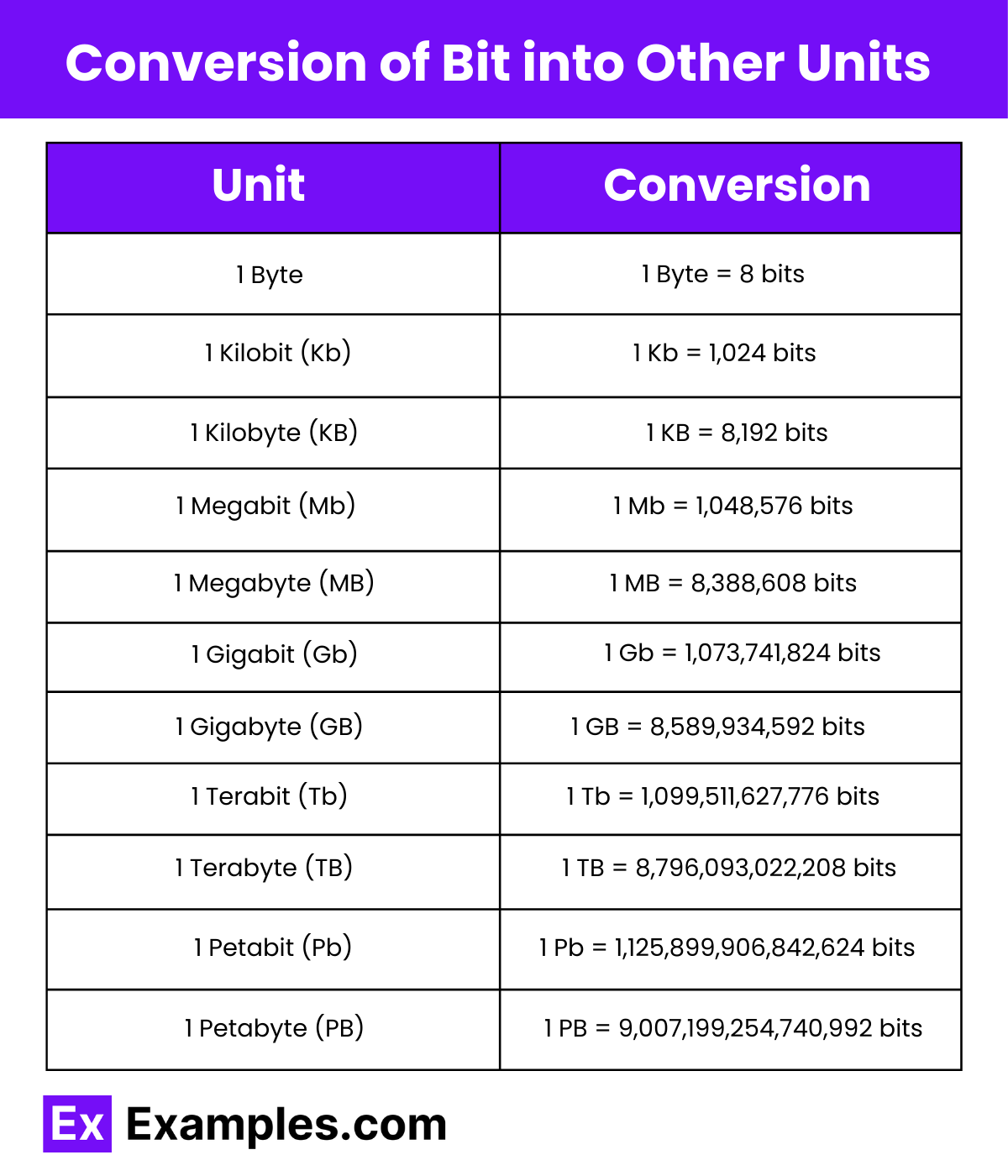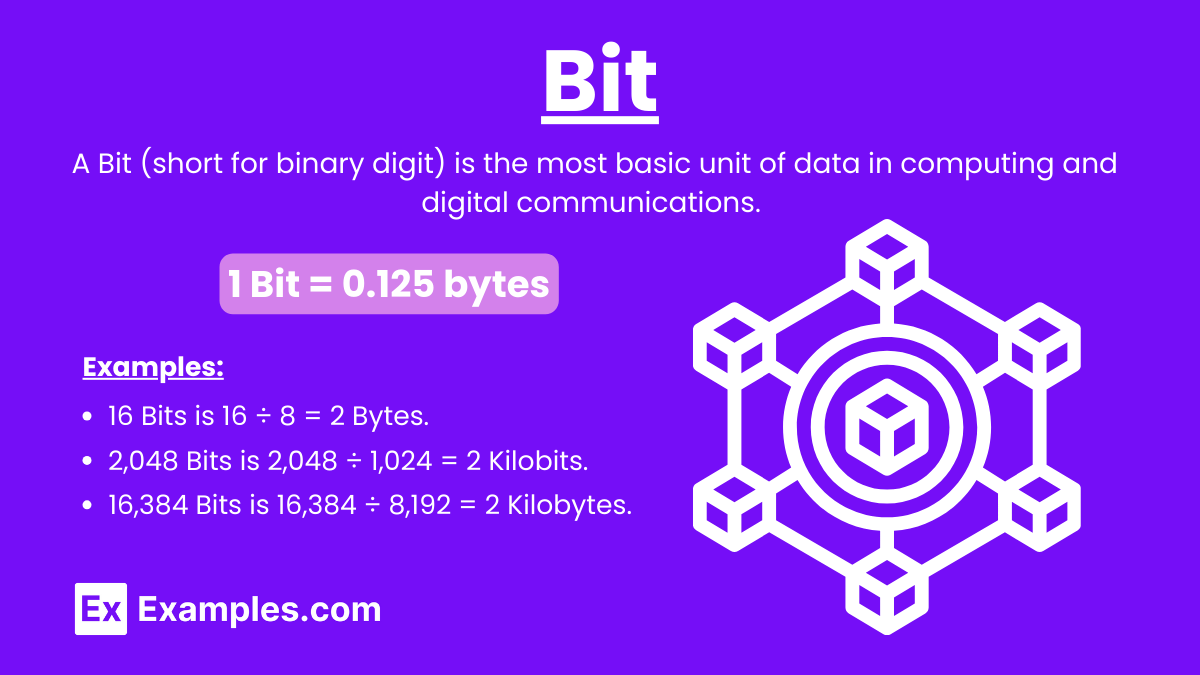9+ Bit Examples to Download
A bit (short for binary digit) is the most basic unit of data in computing and digital communications. It represents a state with one of two possible values, typically 0 or 1. These values correspond to different states of a binary system, such as off/on or false/true. Bits are the fundamental building blocks for all forms of data in computer systems and digital networks. In different contexts, other units of speed are used, such as foot per second, meter per second, and miles per second, to measure the velocity of objects. Each of these units provides a specific way to understand the rate at which something moves over a given second, whether it’s data through a network or physical objects in motion.
What is Bit?
Bit stands for “binary digit” and is the most basic unit of information in computing and digital communications. It represents a single binary value, either 0 or 1. Bits are the fundamental building blocks of all digital data, encoding everything from simple text to complex multimedia content. Understanding units of measurement is essential in various fields, including data transfer rates. Different measurement units are used to quantify speed and length, such as meters or feet. A measurement chart can help convert between these units, ensuring accuracy and clarity in communication.
How Big is a Bit?
1 bit = 0.125 bytes
1 bit = 0.000125 kilobytes (KB)
1 bit = 0.000000125 megabytes (MB)
Conversion of Bit into Other Units

| Unit | Conversion from Bits |
|---|---|
| 1 Byte | 1 Byte = 8 bits |
| 1 Kilobit (Kb) | 1 Kb = 1,024 bits |
| 1 Kilobyte (KB) | 1 KB = 8,192 bits |
| 1 Megabit (Mb) | 1 Mb = 1,048,576 bits |
| 1 Megabyte (MB) | 1 MB = 8,388,608 bits |
| 1 Gigabit (Gb) | 1 Gb = 1,073,741,824 bits |
| 1 Gigabyte (GB) | 1 GB = 8,589,934,592 bits |
| 1 Terabit (Tb) | 1 Tb = 1,099,511,627,776 bits |
| 1 Terabyte (TB) | 1 TB = 8,796,093,022,208 bits |
| 1 Petabit (Pb) | 1 Pb = 1,125,899,906,842,624 bits |
| 1 Petabyte (PB) | 1 PB = 9,007,199,254,740,992 bits |
Just as KBps is used to measure data transfer rates, other units of measurement like yard, centimeter, and millimeter are used to quantify length in various contexts. Using a measurement chart helps convert between these units, providing clarity and precision in different fields of study and application.
Understanding how to convert bits into other units is essential when dealing with data storage, memory size, and data transmission rates. Here’s a straightforward guide to converting bits to and from other common units:
Bits to Bytes
Divide the bits value by 8 to convert to Bytes.
Example: 16 Bits is 16 ÷ 8 = 2 Bytes.
Bits to Kilobits (Kb)
Divide the bits value by 1,024 to convert to Kilobits.
Example: 2,048 Bits is 2,048 ÷ 1,024 = 2 Kilobits.
Bits to Kilobytes (KB)
Divide the bits value by 8,192 to convert to Kilobytes.
Example: 16,384 Bits is 16,384 ÷ 8,192 = 2 Kilobytes.
Bits to Megabits (Mb)
Divide the bits value by 1,048,576 to convert to Megabits.
Example: 2,097,152 Bits is 2,097,152 ÷ 1,048,576 = 2 Megabits.
Bits to Megabytes (MB)
Divide the bits value by 8,388,608 to convert to Megabytes.
Example: 16,777,216 Bits is 16,777,216 ÷ 8,388,608 = 2 Megabytes.
Bits to Gigabits (Gb)
Divide the bits value by 1,073,741,824 to convert to Gigabits.
Example: 2,147,483,648 Bits is 2,147,483,648 ÷ 1,073,741,824 = 2 Gigabits.
Bits to Gigabytes (GB)
Divide the bits value by 8,589,934,592 to convert to Gigabytes.
Example: 17,179,869,184 Bits is 17,179,869,184 ÷ 8,589,934,592 = 2 Gigabytes.
Bits to Terabits (Tb)
Divide the bits value by 1,099,511,627,776 to convert to Terabits.
Example: 2,199,023,255,552 Bits is 2,199,023,255,552 ÷ 1,099,511,627,776 = 2 Terabits.
Bits to Terabytes (TB)
Divide the bits value by 8,796,093,022,208 to convert to Terabytes.
Example: 17,592,186,044,416 Bits is 17,592,186,044,416 ÷ 8,796,093,022,208 = 2 Terabytes.
Difference Between Bits and Bytes
| Feature | Bits | Bytes |
|---|---|---|
| Definition | The smallest unit of data. | A unit of data composed of 8 bits. |
| Symbol | b (lowercase) | B (uppercase) |
| Size | 1 bit | 8 bits |
| Usage | Data transfer rates (e.g., internet speeds) | Data storage capacity (e.g., file sizes) |
| Example | 100 Mbps (Megabits per second) | 100 MB (Megabytes) |
| Measurement | Typically measured in bits per second (bps) | Typically measured in bytes (B), kilobytes (KB), megabytes (MB), etc. |
| Binary Value | 0 or 1 | Combination of 8 bits (e.g., 01010101) |
| Common Prefixes | Kilobit (Kb), Megabit (Mb), Gigabit (Gb), Terabit (Tb) | Kilobyte (KB), Megabyte (MB), Gigabyte (GB), Terabyte (TB) |
| Context | Networking, data transmission rates | Data storage, memory size |
Where do you use of Bit
- Digital Communication: Bits are used to represent and transmit data in digital communication systems. Every piece of information sent over the internet, through mobile networks, or between any digital devices is encoded in bits.
- Data Storage: Bits are the building blocks of all data storage. Hard drives, SSDs, memory cards, and other storage devices store data as sequences of bits. The capacity of these devices is often measured in multiples of bits, such as bytes, kilobytes, megabytes, gigabytes, and so on.
- Computer Processing: Computers process information in bits. The CPU (central processing unit) performs operations on bits according to binary logic. The speed and efficiency of a CPU are often described in terms of how many bits it can process at once, such as 32-bit or 64-bit processing.
- Digital Media: Images, a, and video files are all encoded in bits. The quality and size of these media files depend on how many bits are used to represent each element of the file (such as pixels in an image or samples in an a file).
- Cryptography: Bits are crucial in cryptography, where they represent the keys and encrypted data. The security of cryptographic systems often depends on the length of the keys in bits. For example, a 256-bit encryption key is more secure than a 128-bit key.
- Networking: Bits are used to measure data transfer rates in networking. Common units like bits per second (bps), kilobits per second (Kbps), and megabits per second (Mbps) describe the speed at which data is transmitted over a network.
What does ‘bit’ stand for?
Bit stands for “binary digit,” indicating its binary nature.
How many bits are in a byte?
There are 8 bits in a byte, which is a standard unit of digital information.
What is the significance of bits in data storage?
Bits determine data storage capacity and processing speed in computers and digital devices.
How do bits represent data?
Bits use binary code, combining sequences of 0s and 1s to represent various data types.
What is a bit’s role in binary arithmetic?
Bits are used in binary arithmetic to perform calculations in computer systems.
How does a bit differ from a byte?
A bit is a single binary value, while a byte consists of 8 bits and represents more complex data.
Why are bits important in digital communication?
Bits enable precise, efficient data transmission over digital networks.
How are bits measured?
Bits are measured using prefixes like kilobits (Kb), megabits (Mb), and gigabits (Gb) for larger quantities.
What are common applications of bits?
Bits are used in computing, telecommunications, data storage, and digital media.
Can bits represent text and images?
Yes, bits can represent text, images, and other data types through specific encoding schemes.


